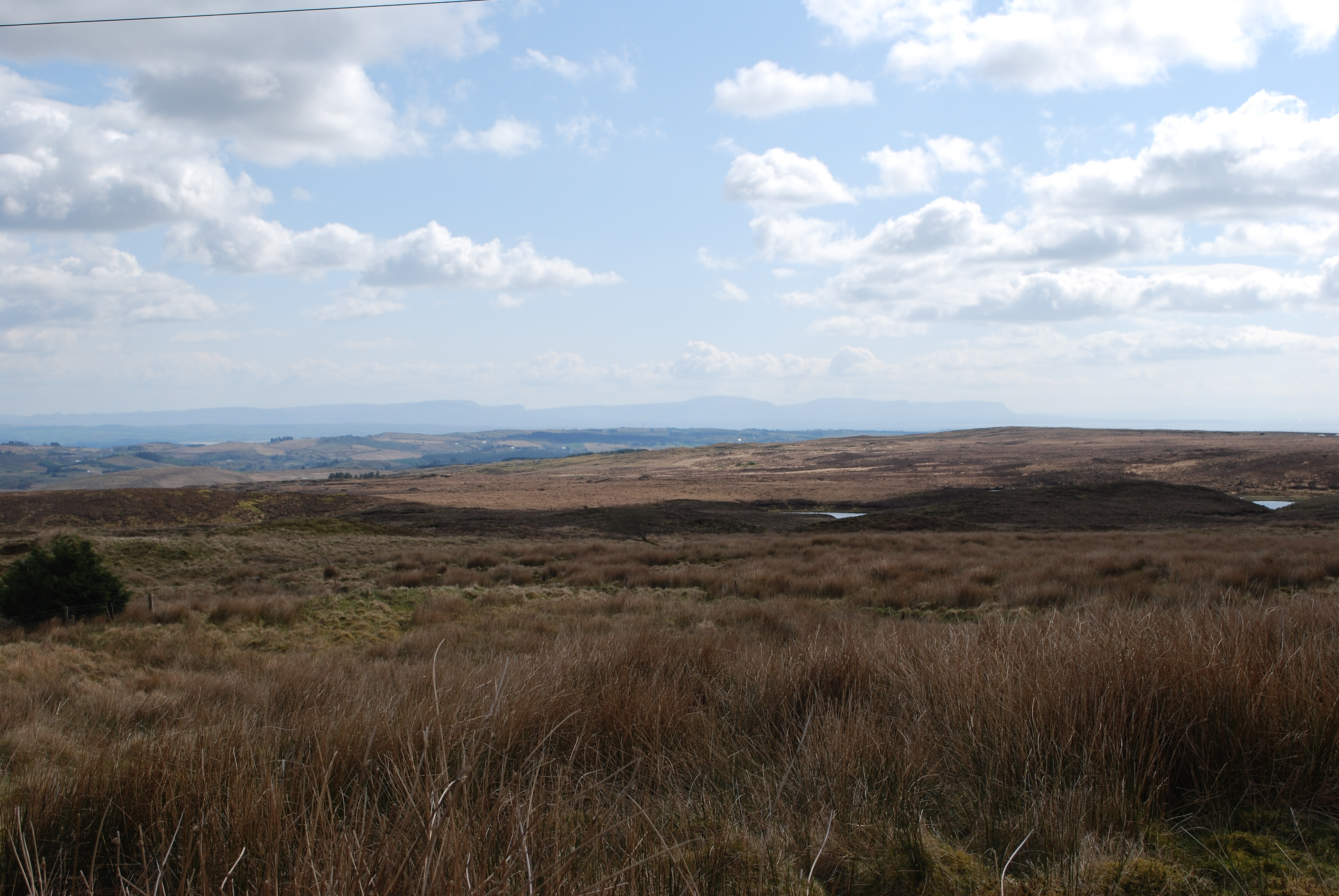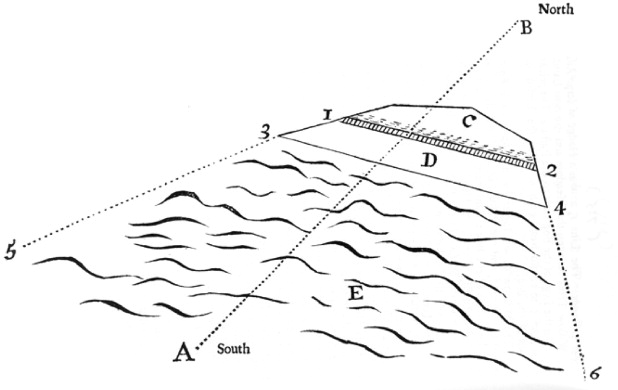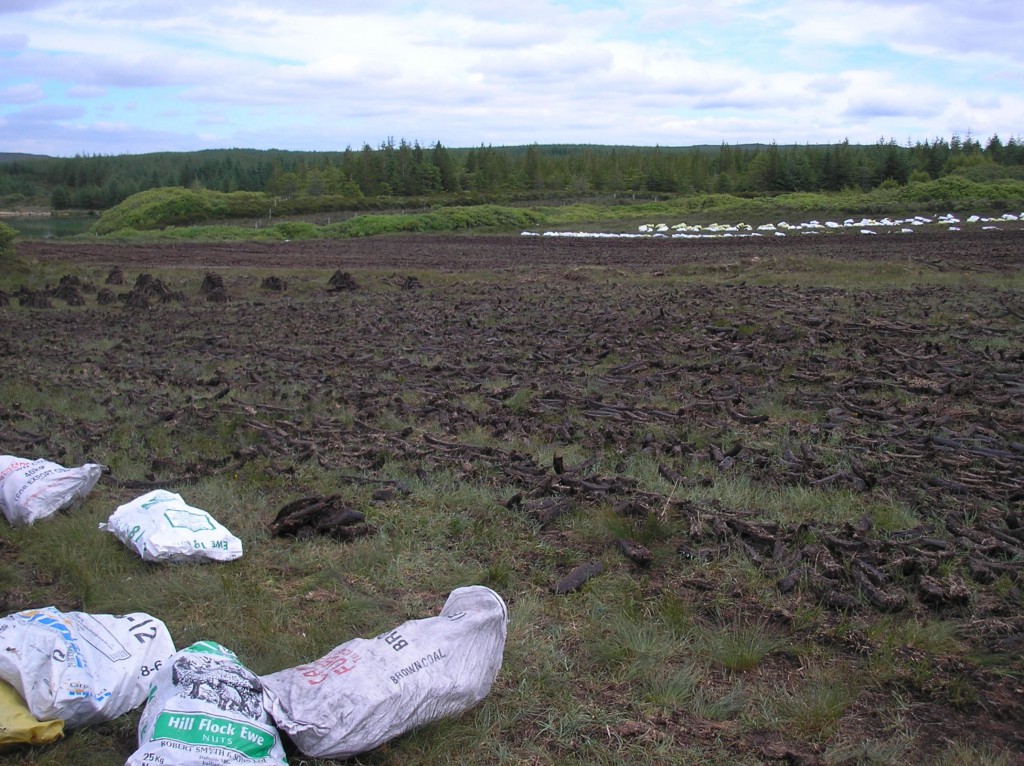
September 16, 2015, by Lucy
Guest post: Bog Bursts at Cappanihane, Ireland, 1697 and 1727
by Dr Angela Byrne, University of Greenwich
The first published account of the phenomenon known as the ‘moving bog’ – the bogslide or bog burst[1] – was published in the Philosophical Transactions of the Royal Society in 1697. It occurred in Cappanihane, a townland in Co. Limerick in the west of Ireland, just over 30km south of the River Shannon. The Down Survey map of 1656–8 clearly shows a considerable “red bogg in common” immediately to the north of “Cappaneneanth”.[2]
The mountain blanket bog occurring in the area is associated with high levels of rainfall – as the warm air of the Gulf Stream meets the cooler air over the island – and low levels of evaporation.[3] This is an important factor in eighteenth-century understandings of the bog bursts that occurred in the area in 1697 and 1727. Large bog bursts excited much scientific and popular interest, and were reported in pamphlets, newspapers, and scientific journals.
Cappanihane, 1697
The noted Irish natural philosopher and political writer, William Molyneaux (1656–98), read the earliest published scientific report of a bog burst to the Royal Society in 1697.[4] Molyneaux communicated a letter by John Honohane describing a bog burst at Cappanihane on 7 June 1697. It was reported that the bog burst covered a meadow to a thickness of 16 feet. The short report included a diagrammatic representation of the direction, depth and extent of the bog burst.
The report noted that immediately beforehand, “for a little Space the Air was somewhat troubled with little Whisking Winds.” The cause of the bog burst, however, was attributed to a “more than ordinary wet Spring [which] occasion’d a prodigious swelling of the Height of the Bog at E, and at length moisten’d the whole, but chiefly the under part thereof, the Water soaking to the Bottom. By this means the Turfy Hill E being as it were undermin’d, naturally sunk down, and consequently press’d the Bog on all hands, chiefly towards the Descent; till the Pasture D was forced on the Meadow C, overturning the intermediate Hedge.” Honohane observed a “Quantity of Water” and “a Descent” as factors that “Naturally explained” the bog burst.
Cappanihane, 1727
A pair of one-page pamphlets published in 1727 reported a recurrence of the Cappanihane bog burst. One pamphlet, printed locally in Limerick city, provided the “stupendous and wonderful” details of the event in summer 1727, whereby some 300 acres of bog covered and destroyed 100 acres of arable land and meadow, breaking down trees with its force and blackening the water of the River Shannon. It was calculated to have progressed at 2 miles per hour. Writing 8 days after the initial burst, the writer states that it covered “around 100 Acres of arable Land, chiefly Potatoe Gardens, and Corn-Fields, belonging to Robert and John Coshin; also cover’d, a fine large Meadow, lying near a Perch, or 21 foot thick.” The writer was, however, not inclined to surmise on the causes of the bog burst.[5]
The second pamphlet, printed in Dublin, contained a copy of an eyewitness account by one W[illiam] Bourke with additional comments by the Dublin-based recipient of the letter. This pamphlet contains additional details, such as the fact that several men were cutting turf on the bog at the time, but no injuries were reported. The eyewitness surmised that the bog burst might have been “occasion’d by a great Inundation of Water,” but ventured no further detail. Writing three weeks after the event, the author stated that the bog “continue[d] still to move.” Indeed, this continued motion was thought more remarkable than the initial removal. The local people evidently agreed, as “there were more People there … than at a Fair … There are Tents Built on purpose, for to Entertain all the Spectators which comes in great Multitudes … to view this strange and Wonderful Bog.”[6]
Bog bursts then and now
These historical accounts of repeated bog bursts in one locality emphasise the event’s status as a spectacle. They also demonstrate an understanding that bog bursts could be caused by excessive rainfall. However, the impact of turf cutting (for fuel) carried out on Cappanihane bog was not considered. Recent scientific studies indicate that bog bursts result from a combination of factors, including increased rainfall, overcutting of peat, and overgrazing. Developments like the erection of wind turbines and accompanying roads, necessitating tree felling, have also increased the risk.[7] In the eighteenth century, before the gathering and tabulation of mean rainfall and snowfall figures, reports like these offer valuable and interesting cultural perspectives on extreme weather and related events.
References
[1] See scientific definitions of varieties of bog burst in A.P. Dykes, ‘Geomorphological Maps of Irish Peat Landslides Created Using Hand-Held GPS,’ Journal of Maps 4/1 (2008): 258–276, here 60. DOI: 10.4113/jom.2008.1029
[2] The Down Survey of Ireland project, available at: http://downsurvey.tcd.ie/down-survey-maps.php [Accessed 13 September 2015].
[3] For clear explanations of different varieties of bog and their formation, see the Irish Peatland Conservation Council website: http://www.ipcc.ie/a-to-z-peatlands/blanket-bogs/ [Accessed 13 September 2015].
[4] J. Honohane, ‘Part of a Letter Dated June 7 1697 Giving an Account of a Moving Bog in Ireland. A Description of This Bog, and Account of the Motion Thereof. By Mr. John Honohane. Communicated by William Molyneux, Esq,’ Philosophical Transactions 19 (1695–7): 714–16.
[5] The Wonder of Ireland, or, a Strange and Surprizing Account of the Moving-Bog, near Draleen, in the County of Limerick (Limerick, Samuel Terry, 1727).
[6] [W. Bourke] A Strange and Wonderful Account of the Removal of a Turf-Bog, in the County of Limerick … (Dublin, Christopher Dickson, 1727).
[7] Irish Peatland Conservation Council, ‘Habitat Loss of Peatlands,’ available at: http://www.ipcc.ie/a-to-z-peatlands/peatland-action-plan/habitat-loss-of-peatlands/ [Accessed 13 September 2015]. See also, for example, ‘Locals Believe Windfarm is Linked to Bog Slide Disaster: Objections to Windfarm Pointed out Landslide Risk,’ The Kerryman, 28 Aug. 2008 http://www.independent.ie/regionals/kerryman/news/locals-believe-windfarm-is-linked-to-bog-slide-disaster-27377601.html [Accessed 10 September 2015].
Acknowledgements from the Weather Extremes team
A big thank you to Angela for her fascinating blog post. You can contact Angela by email: a.byrne@gre.ac.uk and follow her on twitter @abyrne_history. She is currently tweeting from the diaries of John Lee FRS which document his travels around Ireland 1806-1807. The weather-rich entries are what first alerted us to Angela’s work!
No comments yet, fill out a comment to be the first



Leave a Reply